Integrated Healing: Local Hospital Elevates Local Healthcare, Expands Reiki Services
Opinion Advocates for ideas and draws conclusions based on the author/producer’s interpretation of facts and data.
Northwell Facility Blends Best of West, East for Holistic Wellness
By Adam Stone
Before examining today’s local world, let’s take a quick time machine visit back a century, to the tranquil foothills of Kyoto, Japan, in March 1922.
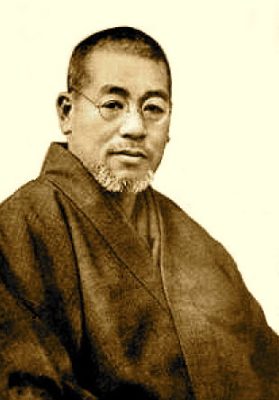
A modest man by the name of Mikao Usui had just scaled Mount Kurama, and initiated an intense three-week period of meditation.
On the 21st day, Usui reported receiving a divine revelation, including the symbols and techniques that would become the foundation of the healing power of Reiki.
By the late 1930s, a Japanese-American woman, Hawayo Takata, helped import the practice, planting seeds of the methodology in the United States.
Some of those seeds have since sprouted here in our backyard.
Almost 102 years after Usui’s discovery – which was also rooted in more ancient teachings – Northern Westchester Hospital (NWH) nurse Serena Allen serves as a contemporary conduit of the method Usui discovered on that Japanese mountaintop all those years ago.
In 2012, while living in the Bay Area, where she’d resided since 1999, Allen was trained by a master practitioner of Reiki. (The word itself is composed of two Japanese characters: “rei,” signifying universal spirit, and “ki,” representing life force or energy.)
Allen had been previously introduced to Reiki through a gift from her mother about a dozen years ago. She thought she was just getting a massage at a local center at Mariandale in Ossining. But what she received instead was a spiritual awakening through Reiki.
“It was such a powerful healing experience for me that it piqued very strong curiosity, and I was determined to learn how to do it myself,” she said of the visit, in 2010 or 2011.
As a result, and about 6,800 miles and a century away from its early 20th century emergence, Allen can now offer the healing power to area patients and medical staff alike, and to profound effect.
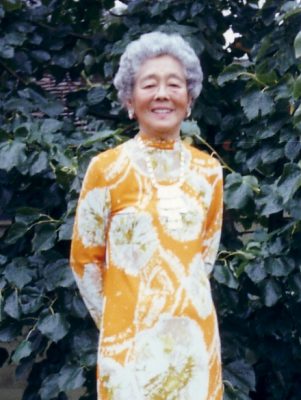
‘All Improves’
The Briarcliff High School product dreams of an eventual outpatient integrative health center accessible to the entire community.
But she’s already able to help many patients and staff in need.
For instance, Allen established a program called Reiki on the Run, an innovative wellness initiative, at five area Northwell Health facilities, offering relaxation and stress reduction for staff. This way, staff stationed at NWH’s satellite offices can benefit from her service, in addition to personnel at the Mount Kisco Hospital.
“There’s plenty of people that have come in very stressed out, very anxious, like, really rattled from whatever kind of a workday that they’ve had, and they leave calm and peaceful and grounded and centered,” Allen told me in an interview last week. “People have told me that their mood is better for the rest of the day, that they sleep better at night, that their relationships, either with their colleagues or patients or their loved ones at home, all improves.”
But there’s a healthcare benefit for all of us as a result of the treatment for workers.
“Patients definitely benefit from staff being well taken care of, because when the staff are okay, they can just do a much better job of being present and their best self for patient care,” explained Allen, who also had experience in pediatric nursing at community clinics before becoming a healer.
Stress = Mess
The research about how stress negatively impacts our physical heath is overwhelming. Chronic stress can contribute to increased inflammation, heightened blood pressure and a weakened immune system, ultimately ushering in disease.
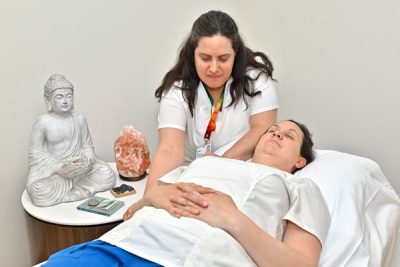
Depression, anxiety, and stress have also been linked to accelerated development of cardiovascular risk factors and poor heart health, as a pair of new studies showcased two weeks ago at the American Heart Association’s Scientific Sessions 2023 conference in Philadelphia reported.
It’s within that backdrop that the Reiki on the Run program is growing.
Just five months ago, the initiative was approved for renewed grant funding for another year, after being originally introduced in June 2022.
It expanded in the late spring from its original three locations – Yorktown Imaging, External Affairs and Chappaqua Crossing – to five Northwell Health ambulatory facilities, adding satellite offices in Ossining and Armonk.
The program is supported through NWH’s Patient Centered Innovation Fund, a grant initiative established in 2015.
Shock and Awe
Speaking of patient-centered care, it’s not just staff who benefit from Allen’s unique training. She also tends to hospital patients in need, including those undergoing cancer treatment and people managing stress.
She recounted an incredible interaction from about two months ago with a patient who’d broken her hip, arriving at the hospital agitated and in excruciating pain.
Despite being administered pain medication, relief wasn’t coming quickly enough. The woman started having a panic attack. At the urging of her daughter, the patient reluctantly allowed Allen to gently touch her feet, initiating a Reiki session.
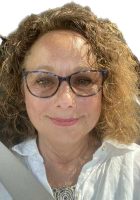
Through a combination of Reiki, guided visualization and calming dialogue, the patient shifted from a state of uncontrolled anxiety to serenity within about five minutes.
“This very agitated patient went from panic, kind of screaming, yelling, totally unsettled, to nearly asleep,” Allen said, adding that “everybody in the room was shocked, including myself.”
It was actually a perfect example of how eastern approaches can work in tandem with more conventional western medicine.
When the energy starts to flow, it connects with the relaxation response of the nervous system. The patient’s body was back in balance, which allow drugs to work optimally.
“I’ve seen that it actually helps people digest and metabolize their medication better,” Allen remarked.
Emotional and Physical Pain
As a matter of fact, when it comes to symptoms that Reiki can best help address, digestive issues appear to be among the treatable low-hanging fruit.
“I’ve seen it improve digestion rapidly because what Reiki is doing is it’s removing energy blocks and restoring balance and flow to each of the energy centers in the body that are known as chakras,” Allen said.
From what I can gather, given the proven mind-body connection, effectiveness can be enhanced or mitigated by a patient’s openness to the technique, although you can experience benefits regardless of initial belief.
Actually, just seven months ago, researchers at the Washington University School of Medicine discovered a direct link between the brain’s movement control and areas responsible for thinking and bodily functions.
“We’ve found the place where the highly active, goal-oriented ‘go, go, go’ part of your mind connects to the parts of the brain that control breathing and heart rate,” study author Dr. Evan M. Gordon stated at the time. “If you calm one down, it absolutely should have feedback effects on the other.”
It’s all about decluttering and calming the mind.
Feel the Energy
Also, given the fact that a Reiki session can help release trauma from the body, it’s often an emotional experience.
Reiki is known for alleviating insomnia, migraines and chronic physical pain, such as from arthritis as well.
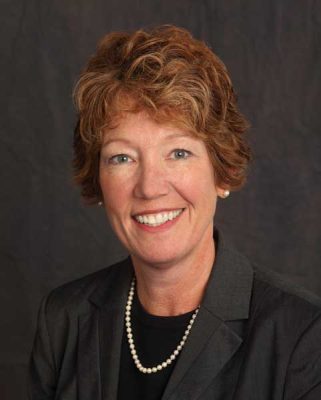
“Sometimes tears are released, but it’s like a very healing release of tears,” Allen said. “I never, ever promise anybody that their pain is going to be changed or reduced in any way. But guess what? It happens all the time. People tell me, like, ‘Oh, my gosh, my incisional pain doesn’t hurt anymore,’ or, ‘Oh, my gosh, my headache went away.’”
I asked Allen to walk me through exactly what sessions look and feel like for the uninitiated.
She stressed how she creates a tranquil environment, incorporating elements such as soothing music and aromatherapy. The hands-on healing process involves strategic placement on or near what are called the body’s “chakras” to restore energy flow.
“My hands get very warm,” Allen also noted. “There’s heat and tingling under my hands, and it just helps to move the energy, the blocked energy, and restore balance and flow to each of these energy centers.”
Allen’s hands move from the top of the head to the forehead to the throat area, over the upper chest, through the heart center, down to the upper belly, over to the lower belly, to the knees and then down to the feet. The entire time heat is intensifying under her hands.
People get more and more relaxed as sessions unfold. Their breathing slows down, their eyes are usually closed.
“Most of the time, people enter a sleep-like state where the mind is just so quiet that it’s really not actively thinking,” she said. “They just kind of go into this blissful Zen state, for lack of a better word. And some people fall asleep, if that’s what they really need, but it depends on the individual.”
By the time she finishes at a patient’s feet, she helps them “release any final energy that’s ready to go.”
“I guide people through the visualization, allowing them to release anything that they’d like to be free from, letting tension or stress be released, letting worried thoughts be released, letting energy that doesn’t belong to them be released,” she said.
Proof in the Pudding
I did ask Allen if there was any compelling data to illustrate results for our readers.
As it turns out, her Reiki on the Run program has already aided more than 400 satellite staff participants. (An additional 600 or so NWH staff members have also benefited from the Reiki treatment.)
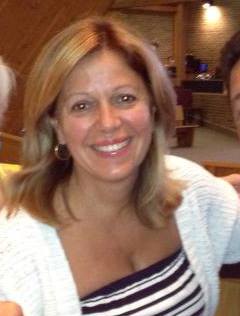
Reiki on the Run participants fill out a survey before and after the treatment about their stress and anxiety levels, measured separately, in a system numbered one to five, defined as “no stress,” “a little stress,” “moderate stress,” “much stress” or “extreme stress.”
About three-quarters of participants reported moderate to extreme stress going into the sessions, and a parallel percentage experienced anxiety levels ranging from mild to extreme.
The results are staggering. Following the sessions, nearly 78 percent of these tense local healthcare workers reported zero anxiety, and about seven in 10 declared feeling no stress at all.
“It’s very clean data because I’m the only practitioner offering it, and so there’s no variables in different people’s hands working on people,” Allen observed.
Testimony
It’s one thing to hear statistics. But it’s a whole other thing to hear firsthand accounts.
Last Friday I interviewed Michele Comen, an occupational therapist at NWH with 29 years of experience.
She pointed out how the demanding nature of her work constantly requires her to channel energy over to patients for pain management, wound care and rehabilitation. The toll on therapists often leads to burnout.
But Allen has been a godsend to Comen for the past year, delivering weekly sessions.
“I would feel more focused, more energetic, less anxious, less stressed, calmer,” said Comen, a certified hand specialist. “I would have more energy to finish the day.”
East Plus West is Best
In fact, one of Comen’s most powerful experiences with Reiki came just a month ago, her most recent treatment before going on leave for surgery.
She’d been dealing with significant professional and personal stress.
“I felt as if I was being bound up by something, bound up by a negative energy,” said Comen, referring to the vanquishing of trauma from her body as a result of last month’s session. “And it released.”
I asked Comen to more specifically describe the physical sensation.
“It feels like a sense of gentle waves, like a wave of cool waves of water on your body that are making you rest and receive a lot of restful feelings, a lot of calm feelings,” she explained.
It’s also desperately important for western medicine to accelerate its embrace of eastern approaches, Comen said. Over the past two decades, she estimates healthcare went from essentially no mainstream holistic offerings to perhaps about 10 percent of care today.
We’ve witnessed positive steps in the right direction. But there’s still ample room for much-needed growth.
“It should really a really be 50-50,” not 10 percent, Comen stated. “But we’re not at that level yet.”
Pancakes
Knowing her likely answer, I asked Comen what forces she believes stand in the way of progress?
“Big Pharma, and they want you to use medication worldwide,” she said. “But I think if we can open our minds and our hearts a little bit to learning and listening to all sorts of types of research we can pull through the naysayers and the ones that want us to just spend money on medication, and we’d be in a better situation.”
The global pharmaceutical market, for those keeping score at home, is valued at roughly $1.5 trillion.
That’s trillion with a ‘T.’
A more balanced approach in treating symptoms – and root causes of symptoms – would be far superior.
“What I do sometimes for my own job is something called myofascial release, which is an ancient Asian technique for relieving twisting and knotting of fascial tissue,” Comen said. “Then I also do wound care and pain management. The patients are also taking medicine.”
Turning to medicine for certain symptoms is often like drizzling syrup on subpar pancakes – it sweetens the surface, offering crucial relief when needed, while alternative healing is akin to creating a fresh stack, getting to the root of the matter for a more wholesome result.
“We need to have a combination of both eastern and western medical outlooks on patients and healing,” the clinician said. “I think it’s highly effective.”
Those Naysayers
I asked Comen how she thought Northwell – New York State’s largest healthcare system, with more than 900 hospitals and care centers – might be able to expand its leadership role in the space.
“They’re doing it with integrative health with people like Serena, who is an asset, a full asset, and a lovely human being, a real healer to our environment,” she replied.
And what other mentality might be impeding wider progress in healthcare writ large?
“People who don’t believe, people who are not willing to understand it, people who are not willing to research it,” Comen asserted.
In order to combat naysayers, Comen stressed that much more research is needed to continue to illustrate effectiveness.
That said, the existing research is more than persuasive.
‘Better Than Placebo’
A 2017 study published in the Journal of Evidence-Based Complementary and Alternative Medicine concludes that Reiki is more effective than a placebo, based on a review of 13 clinical studies.
The peer-reviewed research indicates that Reiki induces a physically relaxed state, reduces resting heart rate, increases heart rate variability and lowers blood pressure, suggesting its potential as a helpful therapy for chronic health conditions and postoperative recovery.
“Reiki,” the study concluded, “is better than placebo in activating the parasympathetic nervous system.”
(Research noted how the treatment should be used as “complementary” therapy, emphasizing its role in conjunction with traditional medical approaches rather than as a standalone replacement.)
Yet it is worth pointing out how a debate over the authenticity of results from alternative healing versus placebo effects perpetuates a false dichotomy; both inherently acknowledge the mind-body alignment, with efficacy grounded in the shared principle that a positive mindset helps achieve better health.
A separate study conducted at Yale-New Haven Hospital and published in the Journal of the American College of Cardiology in 2010, showed how Reiki can improve emotional states in post-acute coronary syndrome patients.
The list goes on, although the list needs to grow to help neutralize those who debunk the practice and are unwilling to accept any healing tactic that doesn’t require popping a pill or paying for a surgical procedure.
Integrative Health
Avoiding the terms eastern medicine or western medicine, NWH instead defines its approach as integrative health, blending the best of all disciplines to aid patient care.
Last week I connected with Associate Executive Director Catherine Manley-Cullen, who oversees the Integrative Health Department at NWH. I also interviewed Angela Toni Russo, the clinical program manager and Allen’s supervisor.
I learned about the integrative health program’s pivot during the pandemic, when services were offered to the hospital’s angst-ridden team members, recognizing the crucial role of mental and emotional well-being to properly care for the community.
My big-picture takeaway from our conference call interview was that NWH has displayed genuine leadership over the past two decades in widening the scope of what healthcare can look and feel like in a U.S. hospital.
The current program includes services such as aromatherapy, medical massage, gentle touch, acupuncture, music therapy and more.
Integrative health at the hospital has evolved from virtually non-existent two decades ago to a comprehensive team today, boasting a diverse staff that has expanded from one person in 2014 to a trio of nurses by 2019, not counting additional specialists such as a music therapist and a cancer center acupuncturist.
But, in a sense, the entire hospital is working toward a more integrated approach.
“We train all of our nurses in holistic core competencies, which include aromatherapy, gentle touch, hand massage and breathing techniques,” Russo said. “So all of our nurses are trained and are tested annually. And so all of our nurses can give holistic care to all of our patients.”
Local Destigmatization
Manley-Cullen, for her part, emphasized how the department’s current strategy and vision for the future features meeting community members where they are, whether at schools, senior centers or events.
She’s also seen anecdotal evidence that suggests burgeoning local awareness and acceptance.
Just recently, at a meeting of the hospital’s President’s Council, she led a session with meditation.
“And I asked first, ‘Has anyone done meditation in the room previously?’ Manley-Cullen recounted. “Almost every single person in that room raised their hand…I think that a lot of these modalities are becoming more ingrained in the community.”
The NWH Cancer Institute’s offerings include acupuncture, music therapy, sound healing, nutritional assessment and emotional support. Patients undergoing cancer treatment are provided with eight free sessions of the holistic services of their choice.
And thankfully, it does appear as if more and more philanthropists are eager to invest in this movement.
“So through some benefactor funding that really has grown, every patient that comes to our cancer center is able to tap into some of these integrative health modalities,” Manley-Cullen told me.
Paging all area philanthropists: give more to this department. It’ll be a monumental way to establish an enduring local healthcare legacy.
Eastward Bound
I’ve done a lot of reporting recently on corporate medicine in the west – how it manifests itself locally – and the horrifying revelations have gotten me thinking about the incomplete healthcare access for U.S. patients to proven alternative treatments.
Given the rich history of eastern approaches spanning thousands of years, you’d think we would have by now transcended the bizarre stigma sometimes associated with methods that undoubtedly work and have worked wonders for millennia.
In a more perfect healthcare orbit, the finest of eastern medicine would be universally and seamlessly incorporated with the magic of western medicine, deploying the best of both worlds.
While there’s some areas of inherent conflict, a holistic approach embracing healthcare options like herbal remedies, clean eating and mindfulness does not need to negate the use of high-tech screening, the appropriate prescribing of medication and the delivery of life-saving surgery.
Granted, there’s been a widening embrace in recent years of eastern methods. Prestigious institutions such as the Cleveland Clinic, the Dana Farber Cancer Institute, Johns Hopkins, the Mayo Clinic and hundreds of others incorporate holistic practices.
But the stubborn stigma is particularly peculiar in our sickly country, where our profit-first healthcare system has contributed to an astonishing six in 10 American adults suffering from chronic disease, according to the Centers for Disease Control and Prevention. (In Japan, one of the healthiest nations in the world, health insurance coverage is universal.)
American Life
Life expectancy here stateside is far shorter than in many other advanced nations.
People live till about 85 years old in Japan on average as compared to just over 76 in the U.S., a staggering difference when you think about it, especially given all of our aggressive efforts to stave off death in the gravely ill. (Men in the U.S. live to just 73 on average and slipping, new research shows.)
In contrast, Okinawans exhibit exceptional longevity and quality of life, boasting 68 centenarians for every 100,000 inhabitants, attributed to local lifestyle, social connections, Japanese cultural traditions, diet, genetics and environmental conditions.
Yes, there are plenty of variables to consider when comparing the lifespans of people from different nations. But there’s no denying the corrosive impact of stress on the human body.
The extreme levels of anxiety attached to modern American life, and the failure of the U.S. healthcare and insurance systems to fully embrace eastern treatments that address root causes, remains truly shameful.
There are also societal factors at play, including the fractured American psyche from issues like gun violence.
‘The Best Teacher’
Living in a nation with nearly 50,000 gun-related deaths per year (versus about nine in Japan) can undoubtedly influence stress levels, anxiety and overall mind-body health, setting aside how the fatalities themselves skew the stats.
The United States reports an alarming 31.1 percent of adults experiencing an anxiety disorder at some point in their lives. (In Japan lifetime and 12-month prevalence rates for anxiety disorders stand at 8.1 percent and 4.9 percent, respectively.)
Yet when patient do receive NWH’s integrated services (even initially skeptical ones) they quickly realize the benefits, Russo said. Some older patients are not familiar with the terminology but they become quick converts. Especially because it’s encouraged by all of the hospital’s physicians, nurses, and social workers.
“And so when they do receive the service, they realize how beneficial it is,” Russo remarked. “That’s really what I find, that the best teacher is just going through the experience. Most people are very open to receiving one-on-one holistic care and just being able to have somebody who has the time to sit with them and talk to them about their whole self.”
But even though holistic healthcare has gained wide popularity in the U.S., and we’ve also seen an explosion of private area establishments open their doors, its inclusion in mainstream American medicine remains only complementary and is not fully integrated into the central bloodstream of the broader system.
That’s what still needs to change – dramatically.
Dream a Little Dream
Even given all of NWH’s local leadership in integrative health, I did wonder how the program might view future growth.
“Yeah, I mean, in an ideal world, we would have additional team members or additional practitioners that are trained in these modalities that then could join our community health team and expand the services even further than we currently do,” Manley-Cullen told me.
I asked the director about Allen’s dream of an outpatient integrative health center accessible to the community.
“Like I said, I think the vision is really to continue to meet the community where they are, whether it’s children in the schools or it’s the seniors at the senior centers,” she said. “I’m not saying that maybe someday we won’t have a center somewhere where people can come, and we’re providing all kinds of different modalities. Possibly, but that’s just not the current strategy.”
It’s obviously a more than reasonable answer from one of the region’s foremost and effective leaders in advocating transformative progress in this department.
But I personally believe there would be a visual power – and a profound practical healthcare benefit – to a brick-and-mortar option, emblazoned with Northwell/Northern Westchester Hospital’s trusted brand.
Allen articulated this point best.
“I really think that it’s important for it to start at large institutions like Northern Westchester, like Phelps, Northwell, so that people see that large medical institutions are not only accepting of it, but promoting it as an important part of health and well-being, that it’s complementary to what they’re also doing with their more traditional medical providers, that it supports well-being,” she concluded. “It supports healing.”
In the world we live in today, we need all of our healthcare providers working creatively to reduce stress and support healing.
And this area is extraordinarily lucky to have Northern Westchester Hospital as a visionary leader to deliver on that vital long-term mission.
Adam Stone is the publisher of Examiner Media. Email him with tips and feedback at astone@theexaminernews.com.

Adam has worked in the local news industry for the past two decades in Westchester County and the broader Hudson Valley. Read more from Adam’s author bio here.
